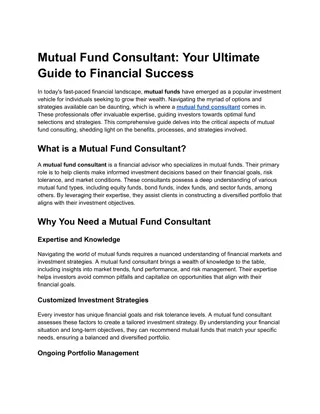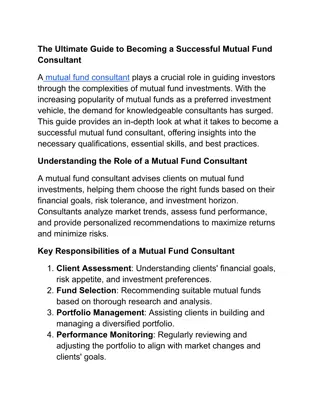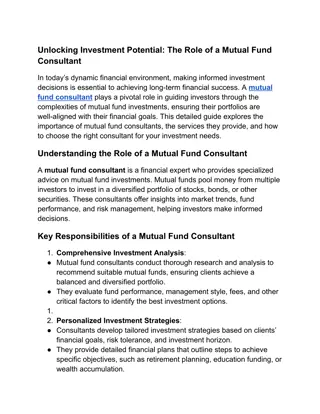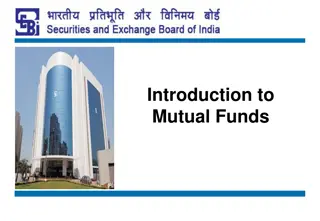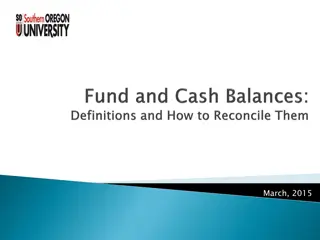Evolution of Mutual Funds Industry in India: A Comprehensive Overview
The evolution of the mutual fund industry in India is detailed from its inception in 1963 through phases such as the formation of Unit Trust of India, the entry of private sector funds, and the emergence of well-known private sector players like ICICI Mutual Fund and HDFC Mutual Fund. The growth of the industry in phased manner, regulatory changes, and key developments are highlighted, showcasing the transformation and stability of the Indian mutual fund sector.
Download Presentation

Please find below an Image/Link to download the presentation.
The content on the website is provided AS IS for your information and personal use only. It may not be sold, licensed, or shared on other websites without obtaining consent from the author. Download presentation by click this link. If you encounter any issues during the download, it is possible that the publisher has removed the file from their server.
E N D
Presentation Transcript
Mutual Fund MRS. M. MARIA JESSICA PG & RESEARCH DEPARTMENT OF COMMERCE, BON SECOURS COLLEGE FOR WOMEN, THANJAVUR.
CONTENTS ENTRY OF PRIVATE SECTOR GROWTH OF MUTUAL FUNDS IN INDIA
ENTRY OF PRIVATE SECTOR IN MUTUAL FUNDS by individuals and companies for profit and is not state controlled. The private sector is the part of the economy that is run are not owned or operated by the government. Therefore, it encompasses all for-profit businesses that with Kothari Pioneer getting the license in July 1993 to operate in India. Private sector entered mutual fund industry only in 1993
Contd. Some of the well-known private sectors in mutual funds are : - ICICI Mutual Fund, - HDFC Mutual Fund, - DSP Merrill Lynch Mutual Fund and - Reliance Mutual Fund, etc.
GROWTH OF MUTUAL FUND INDUSTRY IN INDIA The mutual fund in India started in the 1963 with the incorporation of Unit Trust of India (UTI) . The growth of mutual fund in India has happened in phased manner as under: - Phase 1: Formation and Growth of UTI (1964 to 1987) - Phase 2: Establishment of Public Sector Funds (1987 to 1992) - Phase 3: Introduction of Private Sector Funds (1992 to 1997) - Phase 4: Growth and introduction of SEBI regulations (1997 to 1999) - Phase 5: Emergence of a Large and Stable Industry (1999 to 2004) - Phase 6: Amalgamation and Growth (2004 onwards)
Phase 1 Formation and Growth of UTI (1964 to 1987) The phase 1 witnessed the incorporation and introduction of Unit Trust of India by passing an Act by Parliament. The incorporation of UTI was done by Reserve Bank of India. Post its incorporation, it was the only institution that accepted investments and offered mutual fund units. The first scheme launched by UTI was the Unit Scheme in the year 1964. Later in the years of 70s and 80s, UTI introduced various schemes as per the needs of Indian investors. The first ULIP (Unit Linked Insurance Plan)was introduced by UTI in the year 1971, while the 1st Indian Offshore Fund was launched in the year 1986. In this phase i.e. from the date of inception to the year 1987, the growth of UTI multiplied tremendously.
Phase 2 Establishment of Public Sector Funds (1987 to 1992) The year 1987 perceived the establishment of public sector funds i.e. other public sector institutions like banks and NBFCs were allowed to start mutual fund houses. This developed in opening up of economy and State Bank of India was the first bank to establish a mutual fund company in the year 1987. The ways of SBI were then followed by various other institutions like Canara bank, Life Insurance Corporation of India, Indian Bank, Bank of India, General Insurance Corporation of India and Punjab National Bank introducing their own mutual fund companies. During this period, the asset under management under this sector increased from Rs. 6,700 Crores to a screaming Rs. 47,004 Crores as investors in India showed great interest in this financial tool and started investing a large part of their salary in Mutual funds.
Phase 3 Introduction of Private Sector Funds (1992 to 1997) After the successful introduction of Public Sector Funds, the mutual fund industry opened up and witnessed the establishment of private sector funds from the year 1993, giving Indian investors the extensive opportunity to choose mutual funds from public and private sector. On the other hand, it increased the competition for Indian mutual fund companies.
Phase 4 Growth and introduction of SEBI regulations (1997 to 1999) As the mutual fund sector was witnessing and achieving newer heights, it was important to create a body that created comprehensive rules and regulation for this industry and creating a responsible organisation to overlook the working of this sector. This gave birth to incorporation of SEBI Regulation in 1996. SEBI introduced standardization and set uniform rules and regulations for all funds. It was during this phase that SEBI and AMFI launched an awareness scheme for investors of mutual funds.
Phase 5 Emergence of a Large and Stable Industry (1999 to 2004) This phase witnessed the integration of the entire industry with a similar set of rules and regulations. The uniform and standardized operations and regulations made it easier for investors to invest in various mutual fund companies resulting in increase of asset under management from Rs. 68, 000 crores in previous phase to over Rs. 1.50 lakh crores during this phase.
Phase 6 Amalgamation and Growth (2004 onwards) The mutual fund industry has seen immense growth and globalization since the day of its incorporation. From the year 2004, this industry witnessed integration as there were many mergers, demergers and acquisitions of companies and schemes like Allianz Mutual Fund taken over by Birla Sun Life, PNB mutual fund by Principal etc. Thus, since the year 2004, this industry is managing and integrating new players, dealing with mergers and acquisitions and continuing its excursion towards growth.






